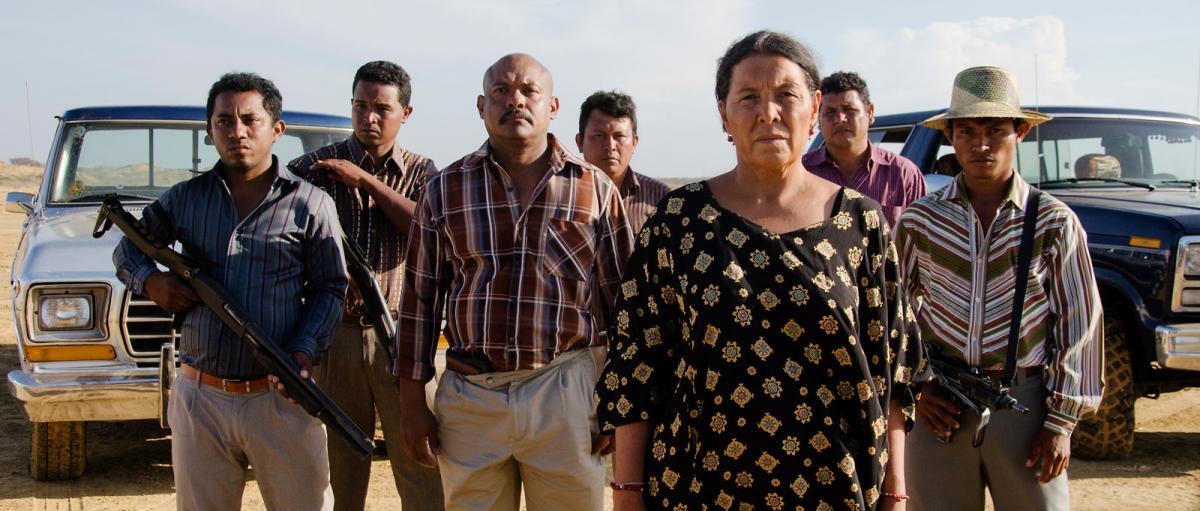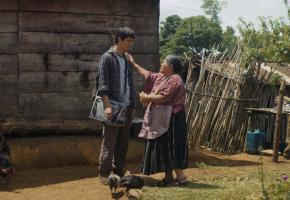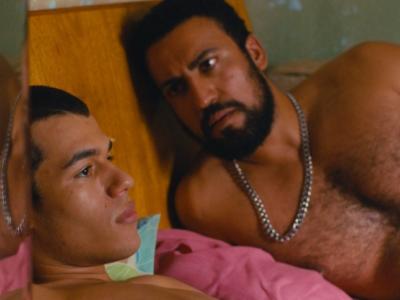José Acosta and Natalia Reyes
‘Birds of Passage’ directed by Cristina Gallegos and Ciro Guerra (Embrace of the Serpent) opened the Director’s Fortnight at Cannes 2018 and has also received many awards, including Best Screenplay for Jacques Toulemonde Vidal and Maria Camila Arias (Naguib Mahfouz Prize - Egypt), the Fénix Award for Best Actress for Carmiña Martínez, the Fénix Award for Best Original Score by Leonardo Heiblum plus numerous nominations.
Representing Colombia at the 2019 Oscars, this excellent film sadly missed out on being among the last five nominees for ‘Best Film in a Foreign Language’ by a hair, being in stiff competition against productions like Cuarón’s ‘Roma’ and ‘Shoplifters’ by Hirokazu Kore- eda.

Carmiña Martínez as Ursula, the matriarch, with her supporters.
The original idea for ‘Birds of Passage’ first emerged when Cristina Gallego and Ciro Guerra were filming another project in the north of Colombia. There, they began to hear stories about the effects of the drug trade on the local indigenous populations. Eventually, in their research they found the Wayuu people and began to understand their ways and how their traditional lives had been changed. ‘Birds of Passage’ owes much to various genres, from gangster films and westerns, to crime thrillers and ‘mafia’ movies, but above all the directors chose to respect the traditional story-telling structures of the Wayuu themselves. In the series of five chapters or ‘cantos’, they touch on magic realism, myths and dreams, entering a surrealistic world where spirits can walk on the earth and dreams are interpreted and understood. The cantos are titled: Wild Grass, The Graves, Prosperity, the War and Limbo.
Ciro Guerra emphasizes that they were not going after a clear realism, but wanted to find the truth via the way the Wayuu themselves looked at reality, turning it into a myth and in the manner by which they transmitted their traditional oral histories. “It works as literature for them, each ‘canto’ reveals a specific theme and a specific story [in the chain of events]”

Natalia Reyes as Zaida
The story unfolds when a young girl, Zaida (Natalia Reyes) prepares herself to ‘come out’ and present herself as ready for marriage to the best suitor. Rapayet (José Acosta) is immediately smitten and asks for her hand. The matriarch of the Wayuu, Ursula (Carmiña Martínez) instinctively suspicious of this young man from another tribe, tries to put him off by requesting an extravagantly high value dowry, including 50 goats and 20 cows, as well as some ceremonial necklaces, convinced that will see him off for good. However, Rapayet, disregarding all omens, is determined to succeed, finds work to save up and then discovers, by chance, some young hippie American Peace Corps workers who are hanging about on the beach looking for some weed.
Aware that there were ‘wild grass’ marijuana plants growing on the farm of his cousin Aníbal (Juán Martínez) up in the hills of the Sierra Nevada de Santa Maria. Rapayet, encouraged by his ‘alijuna’ (outsider) friend Moisés, known as Mocho (Jhon Narváez) makes a deal with the young Peace Corps Americans, who rapidly start to order more. When they also obtain a small aircraft in which to transport the cargo, the drug trade in Colombia is born.

José Vicente Cotes as Peregrino and José Acosta as Rapayet
The growth of the marijuana trade, known as the Bonanza Marimbera began in the 1960s and grew through to the 80s, ushering in decades of violence, as the narcotics trade in Colombia grew to what it was to become, controlled by the mafia and drug cartels. It is deeply ironical that it originally began as a result of President Kennedy ‘s initiative in 1961, with the American Peace Corps project. Designed as a project to contain communism in underdeveloped countries like Colombia, the Peace Corps were, ostensibly, in charge of assisting rural communities with agricultural developments, buildings, education and health.
However, some of the 64 volunteers soon discovered that high-quality marijuana grew in the Sierra Nevada de Santa Maria and started to traffic small quantities of the product through indigenous groups like the Wayuu. The timing was perfect. In the late 1960s and early 70s, the presence of the Peace Corps coincided with a crisis in the production of cotton due to the influx of synthetic fibres and fabrics in the clothing trade and farmers were desperately looking for another viable crop.
However, the Wayuu are not your ‘noble’ savages, they are neither exploited nor backward. In their own traditions everything is traded, (as with the dowry and the girl). They are familiar with commerce at all levels. Just like any human beings, they are also flawed and subject to the destructive instincts of greed and power. For centuries, they engaged in many forms of commerce, smuggling and doing contraband in order to survive in their extremely harsh landscape. “They achieved a certain set of rules of behaviour that kept their lives in balance and [prevented] the violence from popping up, but when this pure form of ‘capitalism’ arrives [on their doorstep] in such a savage manner, everything is altered and that is the conflict that we wanted to address.”(Guerra), Yet, through this illegal trade, the Wayuu get caught up in a conflict where honour is all and debts can be paid with blood.

Ursula, the matriarch holds the family together, as Cristina Gallego says: “It is not a matriarchal society, but the women are very strong in political and economic terms as well as commerce and we wanted to portray that…She’s a complex character, you don’t know if she is trying to keep the family together, or if she’s conflicted by power, between men and women. She is intuitive and yet she did not take action.” Women are not normally included in the narratives of the historical events, so Guerra felt that adding such a strong female character “… was a way of adding something new to the myth”.
All the characters are well developed and believable, each one with their own personal journeys. Zaida’s younger brother, Leonidas, is rebellious and a loose cannon. Unhappy that Rapayet has come into his family life, he ends up provoking dangerous situations that end badly. Zaida is content with her own ‘hiding’ and incarceration from the world until she can emerge to marry. She understands that the longer she is ‘hidden’ the more her value can rise. Leonidas, on the other hand, is unable to tolerate any restrictions at all. Long-honoured traditions are broken until everything falls apart, and war breaks out between the trading parties.
A very endearing character is the ‘Word Messenger’ Peregrino, Rapayet’s uncle, superbly played by José Vicente Cotes. Traditionally, a ‘Word Messenger’ is a highly respected person, whose word is almost sacred. He is considered untouchable, and the phrase: ‘don’t kill the messenger‘, takes on a special darkness in this tale.
Ursula often warned against trading with, let alone becoming a partner of any ‘alijuna’ or outsider, like Moisés, and in the end, her instincts are proved right. Rapayet’s partner Mocho has no morals or cares, other than for the accumulation of wealth. As a result, Rapayet’s cousin Aníbal eventually acquires some ‘alijuna’ for himself and the scene is set for conflict, despite Rapayet’s efforts not to break the sacred traditions and maintain his honour. He is profoundly affected by the pressures beyond his control which he brought upon them and which, in the end, affects them all.

This film is immaculately shot by cinematographer David Gallego., who was also the DOP on Embrace of the Serpent. His camera does not follow the action in a traditional manner. Gallego has carefully constructed large wide-angle all -encompassing tableaux that are almost static, creating a particular atmosphere and quality in that vast landscape, so that the camera becomes another character in the production, another observer. This is particularly poignant when, in the sparkling new house that stands alone in the bare landscape, they have a luxurious and clearly very expensive large double bed… and yet… just beside it, the camera reveals that they still prefer to sleep in their hammocks.
The visual aspects are enhanced by the contrast between the colourful and exotic clothing of the Wayuu and the stark flat lands of the area. There is an eccentric combination of traditional and modern clothing, from brightly coloured dresses and men in ceremonial skirts to mafioso style dark glasses. Birds and spirits seem to inhabit the spaces without reason.
The award-winning original score by Leonardo Heiblum is immersive and hypnotic.This is a film that is palpably tactile and earthy in many ways, despite the echoes of a Garcia Marquez world of magic realism and spirits. The sound of the constant wind floods the silence, emphasizes the emptiness and aridity of the desert, so that the combination of sound design and score work well together.
The mood is notably different to “The Embrace of the Serpent” although, as with that production, it is also imbued with a profound sadness at the loss of a world of ancient ways.
‘BIRDS OF PASSAGE’ will be on general release and On Demand from May 17th 2019 in the UK.
Directors: Cristina Gallego and Ciro Guerra
Screenplay on an idea of Cristina Gallego: Maria Camila Arias and Jacques Toulemonde Vidal
DOP: David Gallego
Editor: Miguel Schverdfinger
Music: Leonardo Heiblum
Cast:
Ursula Carmiña Martínez
Zaida Natalia Reyes
Rapayet José Acosta
Moisés Jhon Narváez
Peregrino José Vicente Cotes
Leonidas Greider Meza
Aníbal Juán Martínez



















